
How well do you think your school uses social media? Are you up to date with all the latest trends and platforms? Do you make good use of all the features available on various social networks? If you have a budget for advertising or paid promotion, are you spending it wisely?
A social media marketing audit is a valuable exercise that can help your school answer all of these questions and more. Encompassing a forensic analysis of your social media activities across all of your active accounts and platforms, it can provide a roadmap towards continuous improvement and success.
So where do you start? Read on to find out.

1. Defining Your School’s Goals and Priority Social Media Platforms
What are your social media accounts for? Are they tools to drive prospective students towards enrollment at your school? An outlet for your current students and alumni to keep up to date with the latest happenings on your campus? A platform to showcase your school’s cutting edge research and innovation to the wider world? Perhaps all of the above?
Too often, schools fail to properly define the goals of their social media marketing efforts, which can lead them to believe that they are performing better than they are in reality. You might, for instance, have a buzzing Facebook account that attracts a lot of reactions and comments, but fails to significantly drive conversion outcomes. Thus, your team might be under the impression that its social media presence is healthy, and be disappointed to learn that it is not having a tangible effect on reaching enrollment targets.
The key to making sure your approach is effective is to align it with clear, realistic goals. One of the simplest, most intuitive ways to do this is to review your social media marketing strategy alongside your target personas. This will allow you to determine whether your efforts are speaking directly to the needs and wants of the audiences that matter most to you.
Your personas can also help you properly determine which social media channels you should be prioritizing. In an ideal world, your school would probably be very active across most major social networks, but if your resources are tight, this might not be possible. Defining priority channels will help you determine which platforms will provide the best return for your time and money.
Example: A persona of an undergraduate candidate for a business degree. Which social networks do you think this persona would be most likely to be active on?
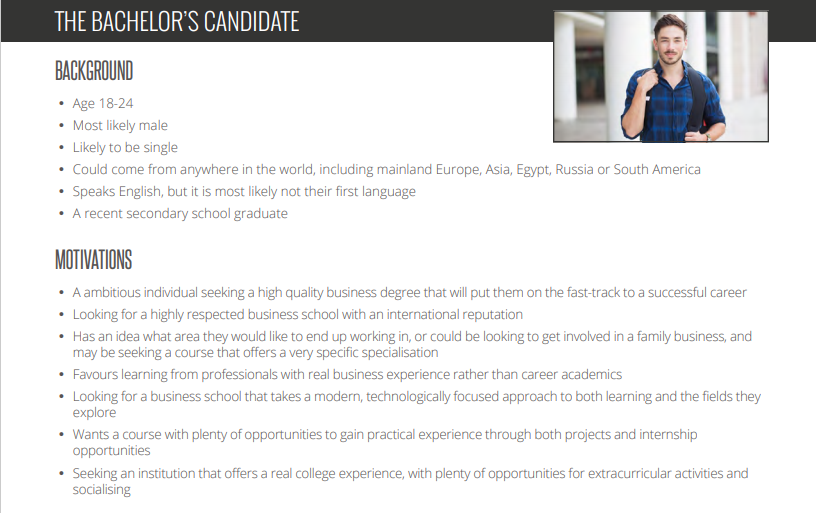
This is an important part of a social media marketing audit for schools, and can be surprisingly instructive. For instance, if you’ve been very active on social media for years, you might be investing a lot of time on Facebook and Twitter, but not a lot on Instagram or other, newer channels which are more popular with younger audiences.
At the other end of the scale, many schools fall into the trap of jumping on the latest new trends and neglecting more established, less fashionable options. A good example of this might be TikTok, the video sharing social network which has amassed over 800 million active users in under four years. While it is arguably the biggest phenomenon the sector has seen over the past couple of years, its audience is mostly made up of younger users. This means it may not be the most effective platform for, say, a career college looking to target mature students.
What’s more, as large as its numbers may be, they are still less than half of the audience commanded by behemoths like Facebook and YouTube:
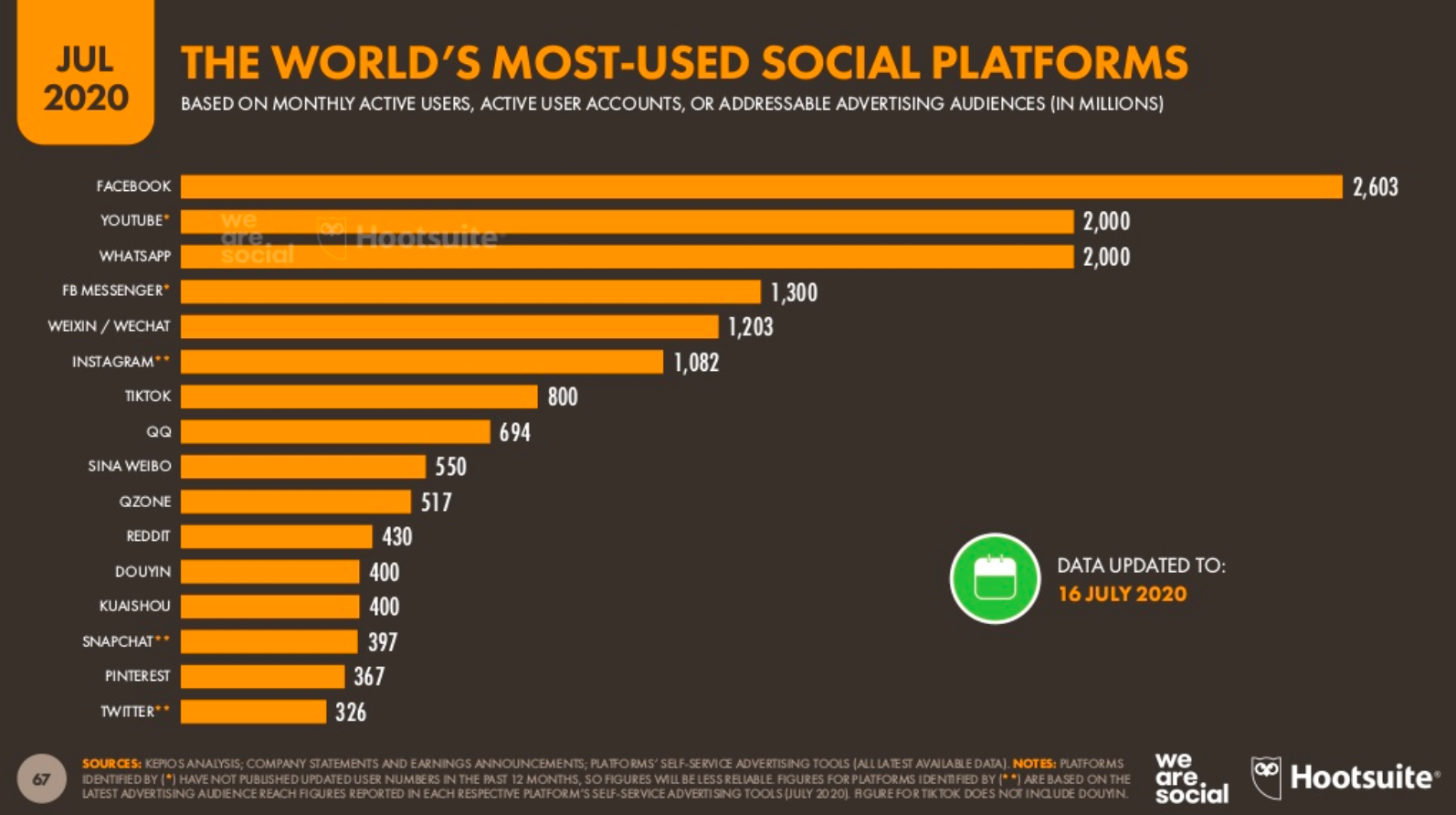
Chasing a new trend like TikTok at the expense of tried and tested platforms could limit your audience overall, rather than expand it.
Properly reviewing your priority platforms through an objective lens and in line with your target personas will help you evaluate the worth of promoting your school on both old and new social networks, and ensure that your resources go where they are most likely to reach the prospects that matter to you.
2. Analyze Your Social Media Marketing Content
A good starting point for analyzing your social media marketing content is looking at how frequently you post on different social networks. Adopting a frequent posting schedule will ensure there is a steady stream of new content to engage your followers. Social media algorithms also favour brands that publish frequently, and will be more likely to feature your posts in your followers’ feeds.
How much or little you should post will largely depend on your resources, and it can vary across different platforms. Experts can also sometimes disagree on the optimal posting volumes on different social networks. These guidelines from Louise Myers offer good general rules of thumb:
- Facebook: At least 3 times a week, ideally once per day, maximum of twice per day
- Twitter: At least once a day, 3-6 times a day is better, optimally 15-23 times per day
- Pinterest: Minimum once a day, 3-5 times a day is better, optimally 10-25 per day
- Instagram: Minimum once a week, 3 times a week is better, optimally 1-2 times per day
- LinkedIn: Minimum twice per week, maximum once a day
- YouTube: Around once per week, but keeping a regular schedule more important than frequency
As you can see, some social networks are more demanding than others. Twitter and Pinterest tend to have very active and engaged audiences, meaning accounts need to post very regularly to maintain visibility. However, being this present on these platforms is only valuable if your audience uses them frequently, which is not always the case for schools.
Facebook and Instagram, which have larger audiences, tend to require less demanding posting schedules, and some even believe that posting too frequently will hurt your visibility and engagement. LinkedIn, meanwhile, is widely believed to require a less frequent posting schedule because of its more professional and less active user base, though more dedicated users and accounts will often still post quite regularly. Expectations for publishing on YouTube are also not as high, partly because of the time-consuming nature of video creation.
Example: Even a large university with substantial resources like the University of Michigan post just 2-3 times per week on YouTube.
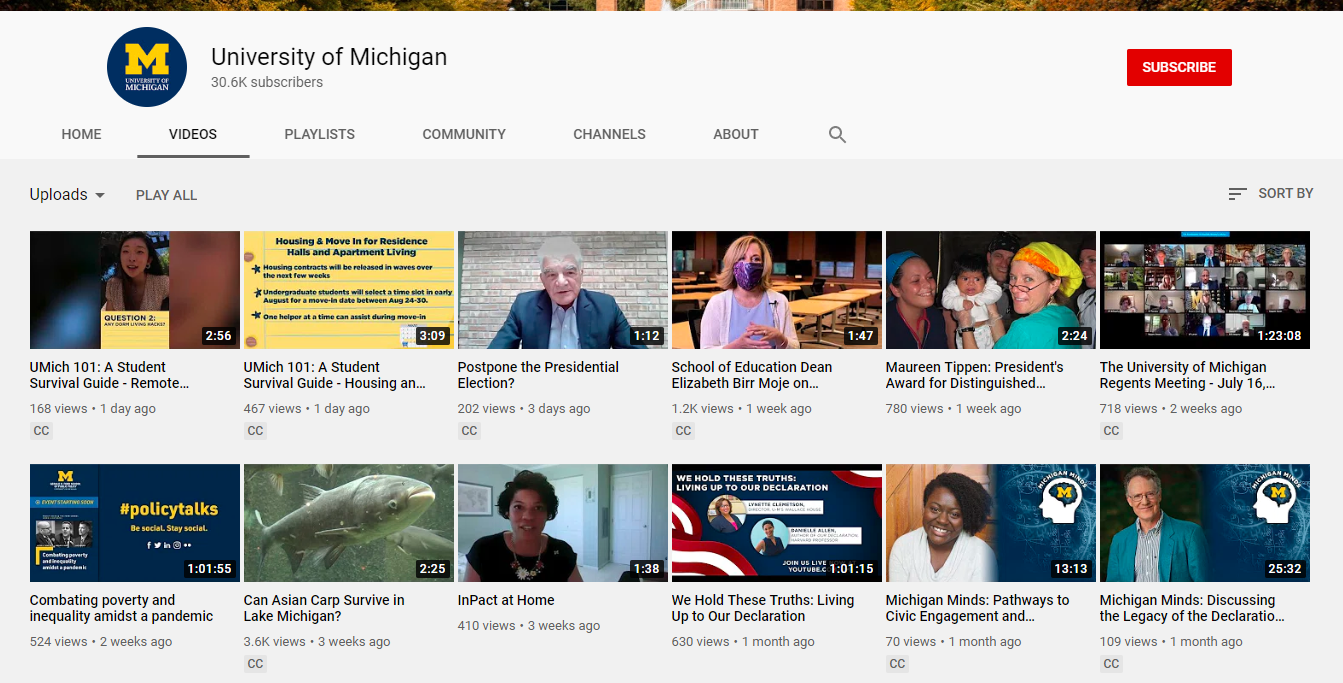
You will also want to look at what formats you are posting in. While many schools still mainly create regular news feed posts across their social accounts, social networks have evolved in recent years to offer a lot more. Livestreams, videos, and stories have become increasingly dominant across certain platforms.
Stories, in particular, is one area that many schools are still struggling to get to grips with. The format’s unique combination of video, images, and graphics, as well as the ‘ephemeral’ nature of the posts (content disappears on most platforms after 24 hours) can make creating effective stories a challenge for even experienced social media managers. Some schools will also overlook some simple things they can do to make their stories more impactful, such as saving Instagram stories to the Highlights section of their profiles to lengthen their lifespan.
Example: Buckinghamshire New University makes good use of its Instagram Stories Highlights, saving Q&As about its programs and other informative, evergreen content. The school also uses a consistent design for its highlights covers.

If your school has not caught up with this trend, an education social media audit could show you the value of doing so.
Aside from format and frequency, you may also want to look at the overall approach you take to social media content. What does your school typically post about? Is the tone and style appropriate for each social platform? And do you variate your approach to posting on different networks, instead of simply replicating posts across channels?
Example: Here, Canadian Business College shared the same blog post on LinkedIn and Twitter. However, the copy for the Twitter post is shorter and snappier, while the Linked message is a bit more formal. You should also note that the LinkedIn post simply shares a link to the page, where the Twitter post actually shares an image, with a hyperlink to the blog within the body text, which can increase visibility on that platform. Small details like this can often be telling.
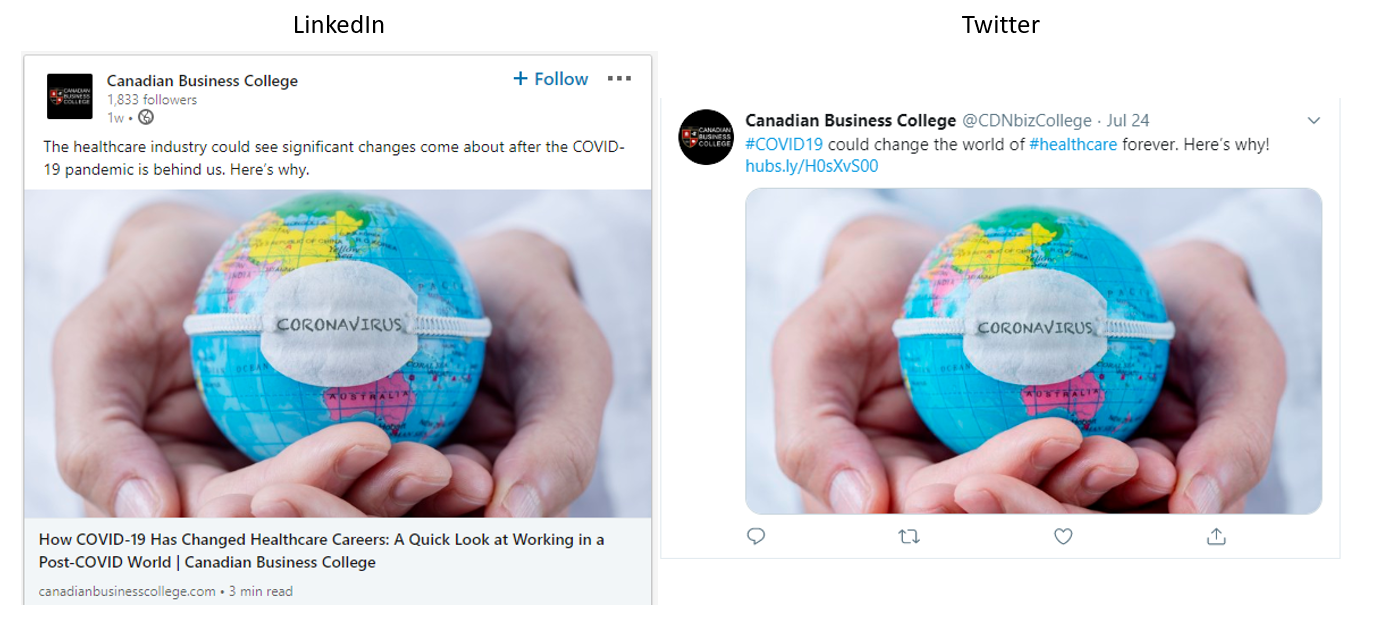
Not only does making sure your posts are unique on each social network ensure they are appropriate for your audience, but it will be appreciated by prospects who use more than one social network, and may want to follow your school through different channels.
If you find it hard to gauge the quality and effectiveness of your social content, evaluating your engagement levels will make it easier. Look at the amount of reactions and comments your posts generate, as well as shares, clicks, and other engagement indicators.
What constitutes strong engagement will largely depend on the size of your school and its social media following. For a smaller school that only has 1,000 followers, for example, averaging around 50 likes for each post would probably represent a strong showing, and would mean that the posts were reaching a relatively large amount of followers and being interacted with by a good proportion of them. A larger university, however, might have over 50,000 followers or more on certain channels. Even if posts averaged around 200 reactions, engagement might be considered low. As a general rule of thumb, anything over around 1% of your followers is considered a healthy amount.
3. Evaluating Your School’s Use of Paid Social Media
In addition to your organic efforts, you should also evaluate the effective of any paid initiatives you are undertaking on different social media channels. Whether you engage in advertising campaigns to drive admissions goals, or just promote or boost posts on channels to improve their reach, you should analyze their effectiveness over a defined period of time in reaching their goals, as well as the average ROI on your budget.
From there, consider whether your targeting, budgeting, creative, or the platforms you are advertising on could be tweaked to improve your results.
If you are not engaging in any paid social media, a digital marketing audit for schools might be a good opportunity to evaluate whether you should be. Often, schools focus on organic social instead of paid under the mistaken notion that organic social is ‘free,’ and therefore more cost-effective.
As illustrated in the previous section, however, the reality is that a competitive organic social presence takes a lot of time and effort, meaning hours of work for your team. Even if you put in the hours, it might still be hard to achieve the results you want, particularly if your school is starting with a low follower base or level of engagement. Devoting some of those resources to well-executed paid campaigns could give you more bang for your buck, and may even be less time-consuming and cheaper in the long run.
4. Are You Doing the Social Media Marketing Fundamentals Well?
As much as you may be tempted to focus on the bigger picture of your social media mix, posting approach, and budgeting, it’s important not to neglect the fundamentals.
Good housekeeping can go a long way on social media, and ensuring that various different aspects of your profile are kept up to date and that you are making the most of everything available can pay dividends.
For instance, many social networks allow brands to include extensive information in the About section of their profiles. On Facebook, for instance, you can include a description of your school, as well as contact information (website, email address, phone number, location), office hours, and your category of business. Ensuring you make the most of this space could help you generate more inquiries.
The site also allows you to link your other social feeds, such as Twitter and YouTube, to Facebook so that visitors can access them through the More tab on your page.
Example: Georgetown University allows visitors to access its Twitter feed from its Facebook page.
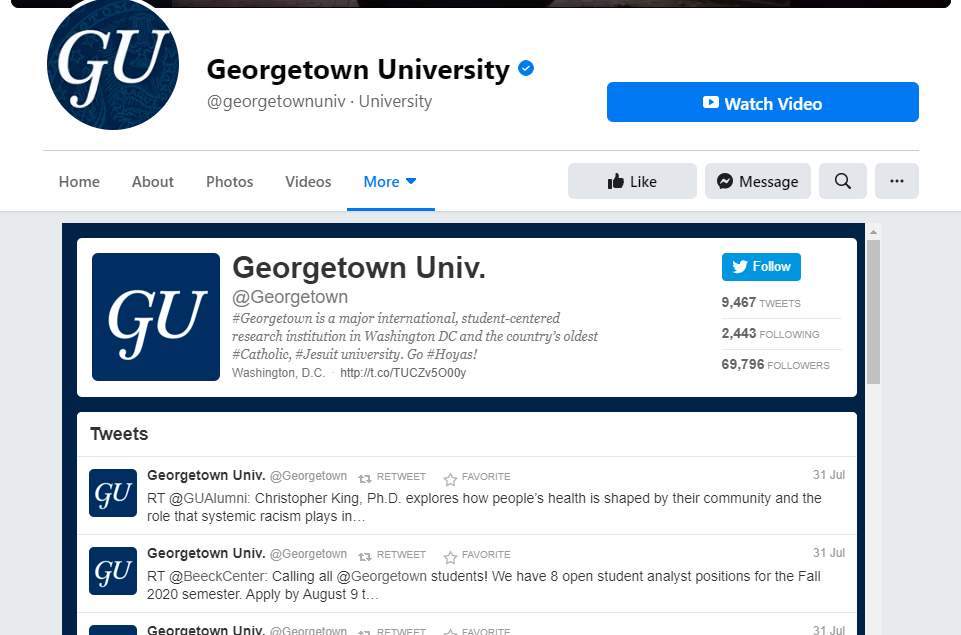
Ensuring that all of your accounts are linked can help drive engagement across different networks.
Other details can be decisive, too. For example, updating your cover images every few months can help keep your profiles looking fresh, and can also allow you to create images to highlight things like upcoming events and application deadlines.
Example: In the wake of the COVID-19 pandemic, CES Dublin has updated its cover image to highlight its virtual classes.

When creating cover images, it’s important to ensure that they are the correct size and resolution for your profile. Outsized or low-resolution cover images can leave a poor impression on social media users.
You should also pay attention to how consistent your branding is across different social channels. Small things like differences in logos, inconsistent use of colour palettes and fonts, or even the lack of frequent usage of your school’s branding elements can weaken your brand, making your accounts look less professional.
While you might think none of these elements would make or break your school’s social media strategy, you would be surprised how much these small details can go a long way.
5. Looking at the Relationship Between Social Media and Your School’s Website
Another important aspect to consider when auditing your social media marketing efforts is how well your social channels work in tandem with your website. For most schools, driving traffic – and hopefully inquiries – to your website will be a key goal of social media initiatives, and its important to measure its success. The Channel Report in Google Analytics should give you a good idea of the level of traffic and conversions social is generating for you.
Example: In this Channel Report, social accounts for just under 15% of website traffic for the school.
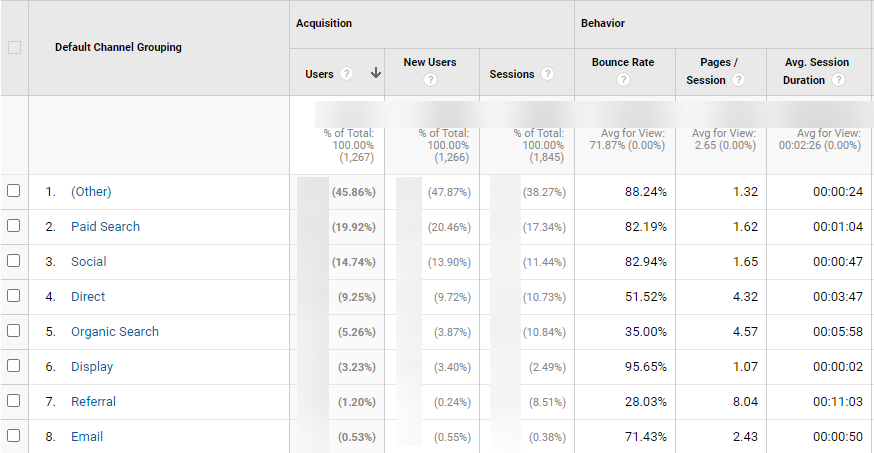
If you find that you are not getting as much traction from social media on your website as you would expect, strategize ways to remedy this. You might want to post more links to content on your website on social, or perhaps consider advertising or promoted posts campaigns to generate more website engagement or conversions.
On the other side of the coin, you will want to consider how well your website drives visitors to your social media accounts. These two channels should work in tandem, with your website encouraging interested prospects to find your school on their favoured social networks and hopefully follow your accounts so that you can welcome them into your online community and nurture their interest. It can also turn enthusiastic prospects, current students, and alumni into advocates for your school.
Accomplishing this can be as simple as placing social buttons in the footers of your web pages to link to your accounts, or placing social sharing buttons on blog and news posts to encourage prospects to help amplify your content marketing efforts.
Example: Princeton University’s Undergraduate Student Blog features social sharing buttons at the top of posts.

You might also prompt prospects to follow you on social media in your Thank You pages and email marketing efforts.
Overall, the goal should be to develop a fully reciprocal relationship between your website and your social accounts, where they both work to strengthen each other.
6. Use a Social Media Marketing Audit for Schools to Evaluate Your Competitor’s Presence
No school’s social media presence is ever perfect, and in many cases, how effective your strategy is in attracting prospects will ultimately come down to how it compares to your main competitors.
With that in mind, there can be a lot of value in carrying out a social media competitor audit for schools. In simple terms, a competitor audit involves analyzing your competitors’ social media presences with the same criteria you are using to evaluate your own. Some of the key points you should be looking to ascertain might include:
- How many followers do they have on your priority social media channels?
- How much engagement are they generating on each social network?
- How active are they on different social platforms?
- How responsive are they to user engagement?
- How well do they integrate social platforms to their website?
- Are they running ads or boosting posts?
- Is their content of a high quality?
- Do they make use of all available formats?
- How strong and consistent is their branding?
You should compare your competitors’ efforts to your own in each of these areas. Seeing how well you measure up to those operating in the same space as you will help you ascertain whether your social media performance is above or below average for schools like yours, and give you realistic benchmarks for success.
In all likelihood, you will probably find that it isn’t as simple as your school being better or worse than your competitors. Rather, you will usually be able to identify certain things that you do much better, others you do much worse, and possibly a lot of things that you do very similarly to one another. Learning from strategies your competition is employing, improving in the areas where you are falling short, and doubling down in cases where you already have a head start will help put you comfortably ahead of them in the long-term.
7. Categorize Your School’s Strengths and Weaknesses on Social Media
After analyzing every aspect of your social media presence in this way, you should have a very clear idea of what you need to do to improve.
Don’t be surprised if it’s a very long list. It isn’t uncommon for a digital marketing audit to result in dozens, even hundreds, of recommendations for changes both small and large that schools should make to its social media presence. And it may be the case that your school simply doesn’t have the resources to address everything right away.
However, there’s no need to be discouraged. If you properly prioritize areas of improvement, you can focus on the things that you feel will have the most positive impact for your school in the medium term, and gradually address other issues as you make progress.
In addition, it’s important not to concentrate too much on addressing the negatives of your current approach and neglecting the positives. If, for instance, you have a very active and engaged Facebook presence but are weaker on other platforms, capitalizing on your strength on Facebook could be just as valuable for your school as trying to grow on other networks, if not more so.
By clearly identifying and categorizing your strengths and weaknesses, what you can build upon, and the problems you need to address, an audit can give you a foundation that sets your school up for social media success for years to come.







